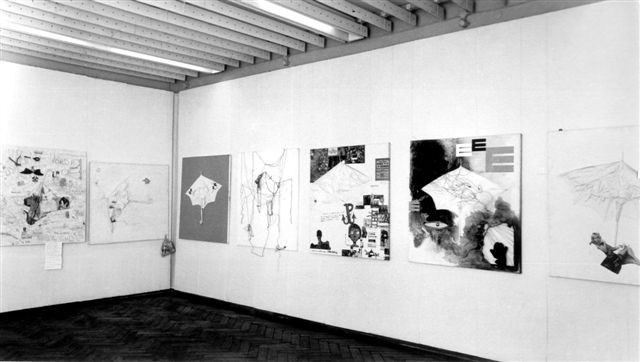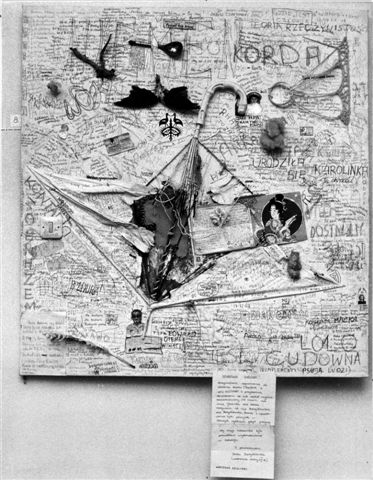On the 21st February 1970, in Warsaw’s Galeria Foksal, Tadeusz Kantor organised the action entitled Multipart (the name was created from fusing bits of ‘multiplication’ and ‘participation’). Forty identical, numbered copies were exhibited, made according to the artist’s instructions: a squashed umbrella was attached to a white canvas 110 x 120 cm, the whole thing was then painted white and given the title parapluie-emballage. Next, at the opening of the exhibition, all the paintings were sold quite cheaply. On the painting – according to a contract which the buyers had signed with Kantor – they were allowed to ‘write insults, commendations, words of approval, commiserations, the worst possible words (…),’ [they could] ‘erase, cross out, draw, (…), do anything at all with the painting (…), make holes, burn it (…), sell it, buy it back, use it to speculate, steal it.’ 1 Additionally, the new owners were obliged to exhibit the works again at Galeria Foksal after they had used the canvases.
On the 20th February 1971, the exhibition The Last Stage of Tadeusz Kantor’s Multipart was organised, at which twenty five parapluie-emballage were shown; they had been contributed by the buyers after they had used the works for over a year. Some of the items had been destroyed or sold, some collectors did not respond to the request to re-exhibit their work. It turned out that the dominant form of participation had been to fill in the white canvas with scribbles and all kinds of objects in the fashion of a collage.
A group of students of the Faculty of Architecture at the Warsaw Polytechnic decided to carry the work which they had brought as a banner to the 1970 1st May parade, subsequently to bury it in the garden of the Zamoyski Palace in Warsaw, close to Galeria Foksal. Krzysztof Kubicki and Marek Młodecki’s film Multipart was a recording of this event.
Number 8 was bought by the under-aged Idalia Bargiełowska, she gutted the umbrella, and wrote her various thoughts on the canvas (…) Ewa Partum, a student of the Academy of Fine Arts, bought number 17 and exhibited it, sticking onto it a comic, in which she told of how she had exhibited Professor Kantor’s work and presented it as her own diploma work. (…) Someone did not touch the umbrella, leaving it pristine and wrote that he had expected that all the others would destroy their umbrellas, so that his one copy of the multiple work would become unique. (…). 2
In his action Multipart, Tadeusz Kantor set out to question the notion of the work of art – the auteur work, the effect of creativity – stepping back from his own creation and presenting merely a concept and a technical description. Denying the uniqueness of a work of art and depriving it of dignity, he simultaneously questioned the position of museums, galleries and collectors.
1. Tadeusz Kantor, Multipart – Warunki umowy, in: Tadeusz Kantor. Metamorfozy. Teksty o latach 1938-1974, ed. K. Pleśniarowicz, Księgarnia Akademicka Wydawnictwo Naukowe, Kraków 2000, pp. 508-509.
2. Bywalec II, Ćwiartka pod parasol; Polityka, no. 11, 13 March 1971; reprinted in: Tadeusz Kantor i Artyści Teatru Cricot 2, ed. J. Chrobak, J. Michalik, Cricoteka, Kraków 2009, p. 66.
ed. Justyna Michalik

The Last Stage of Tadeusz Kantor’s Multipart, Galeria Foksal, Warsaw, 1971, photo by P. Barącz

The Last Stage of Tadeusz Kantor’s Multipart, Galeria Foksal, Warsaw, 1971, work bought by Idalia Bargiełowskia, photo by P. Barącz

